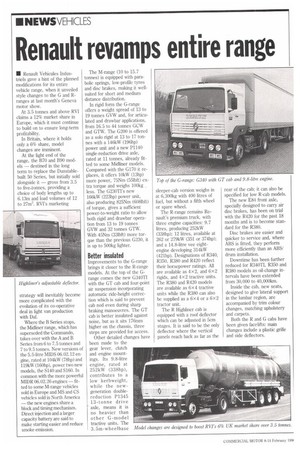Renault revamps entire range
Page 20

If you've noticed an error in this article please click here to report it so we can fix it.
• Renault Vehicules Industriels gave a hint of the planned modifications for its entire vehicle range, when it unveiled style changes to the G and Rranges at last month's Geneva motor show.
At 3.5 tonnes and above RVI claims a 12% market share in Europe, which it must continue to build on to ensure long-term profitability.
In Britain, where it holds only a 6% share, model changes are imminent.
At the light end of the range, the B70 and B90 models — destined in the long term to replace the Dunstablebuilt 50 Series, but initially sold alongside it — gross from 3.5 to five-tonnes, providing a choice of body lengths up to 6.13m and load volumes of 12 to 27in'. RVI's marketing strategy will inevitably become more complicated with the evolution of its co-operative deal in light van production with Daf.
Where the B Series stops, the Midliner range, which has superseded the Commando, takes over with the A and B Series from 6 to 7.5 tonnes and 7 to 9.5 tonnes. New versions of the 5.5-litre MIDS 06.02.12 engine, rated at 104kW (78hp) and 119kW (160hp), power two new models, the S140 and S160. In common with the more powerful M1DR 06.02.26 engines — fitted to some M-range vehicles sold in Europe and MS and CS vehicles sold in North America — the new engines share a block and timing mechanism. Direct injection and a larger capacity battery are said to make starting easier and reduce smoke emission. The M-range (10 to 15.7 tonnes) is equipped with parabolic springs, low-profile tyres and disc brakes, making it wellsuited for short and medium distance distribution.
In rigid form the G-range offers a weight spread of 13 to 19 tonnes GVW and, for articulated and drawbar applications, from 16.5 to 44 tonnes GCW and GTW. The G200 is offered as a solo rigid at 13 to 17 tonnes with a 146kW (196hp) power unit and a new P1140 single-reduction drive axle, rated at 11 tonnes, already fitted to some Midliner models. Compared with the G170 it replaces, it offers 10kW (13hp) more power, 75Nm (55Ibft) extra torque and weighs 100kg _ less. The G230TI's new 166kW (223hp) power unit, also producing 825Nm (608Ibft) of torque, gives a sufficient power-to-weight ratio to allow both rigid and drawbar operation from 13 to 19 tonnes GVW and 32 tonnes GTW. With 45Nm (331bft) more torque than the previous G230, it is up to 500kg lighter.
Better insulated
Improvements to the G-range brings it closer to the R-range models. At the top of the Grange comes the new G340TI with the GT cab and four-point air suspension incorporating automatic ride-height correction which is said to prevent cab nod even during sharp braking manoeuvres. The GT cab is better insulated against noise, but as it sits 176nun higher on the chassis, three steps are provided for access.
Other detailed changes have been made to the gear lever, clutch and engine mountings. Its 9.8-litre engine, rated at 252kW (338hp), contributes to a low kerbweight, while the newgeneration doublereduction P1345 13-tonne drive axle, means it is no heavier than other G-model tractive units. The 3.5m-wheelbase sleeper-cab version weighs in at 6,300kg with 400 litres of fuel, but without a fifth wheel or spare wheel.
The R-range remains Renault's premium truck, with three engine capacities: 9.7 litres, producing 252kW (338hp); 12 litres, available at 262 or 279kW (351 or 374hp); and a 14.8-litre vee eightengine developing 314kW (421hp). Designations of R340, R350, R380 and R420 reflect their horsepower ratings. All are available as 4x 2, and 6x2 rigids, and 4 x2 tractive units. The R380 and R420 models are available as 6x4 tractive units while the R380 can also be supplied as a 6x4 or a 6x2 tractor unit.
The R Highliner cab is equipped with a roof deflector which can be adjusted in 5cm stages. It is said to be the only deflector where the vertical panels reach back as far as the rear of the cab; it can also be specified for low R-cab models.
The new EM front axle, specially designed to carry air disc brakes, has been on trial with the R420 for the past 18 months and is to become standard for the R380.
Disc brakes are easier and quicker to service and, where ABS is fitted, they perform more efficiently than an ABS/ drum installation.
Downtime has been further reduced for R340TI, R350 and R380 models as oil-change intervals have been extended from 30,000 to 40,000km.
Inside the cab, new seats, designed to give lateral support in the lumbar region, are accompanied by trim colour changes, matching upholstery and carpets.
Both the R and G cabs have been given facelifts: main changes include a plastic grille and side deflectors.




















































































































